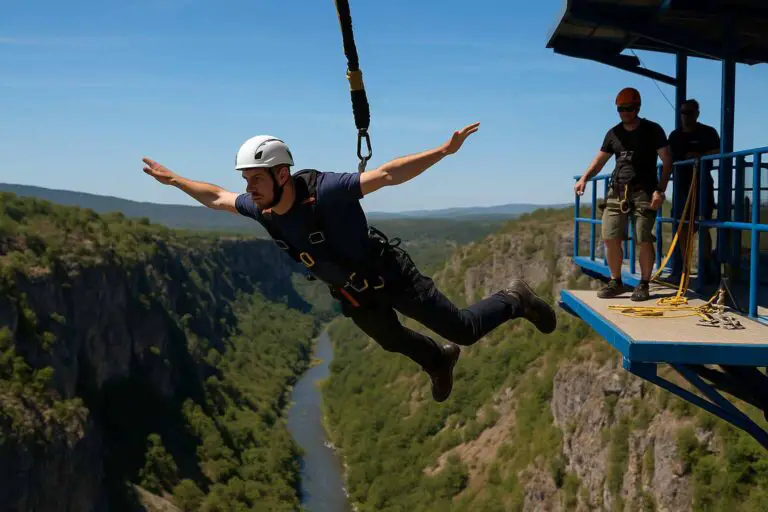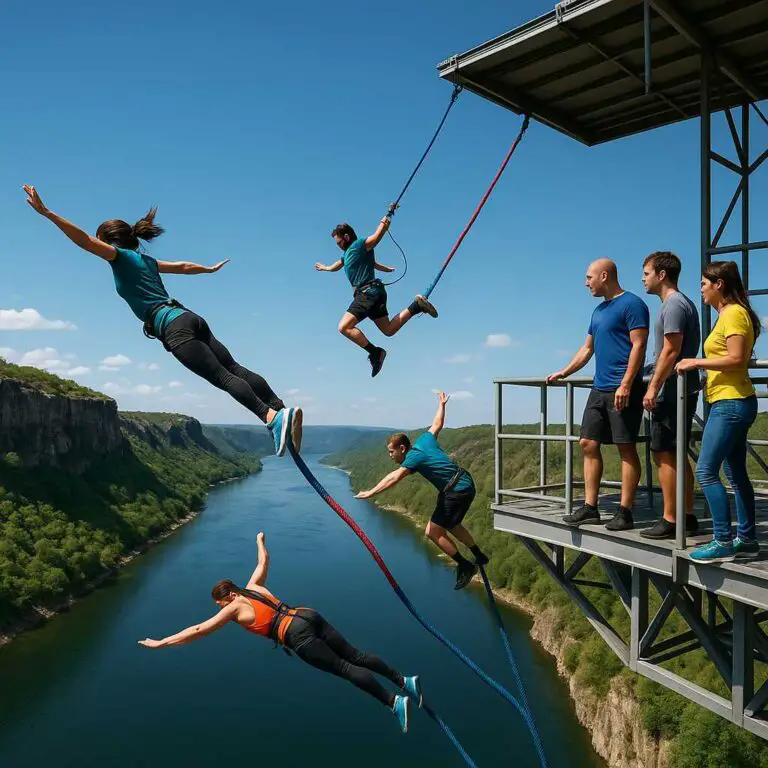Have you ever wondered about the daring world of bungee jumping? The exhilarating experience of leaping from a great height and rebounding back up can be both terrifying and awe-inspiring. But amidst all the excitement, there’s a persistent question that often looms in the back of our minds: Can bungee jumping cause brain damage?
No, bungee jumping does not cause brain damage. The sport is designed with safety measures to prevent harmful impact on the brain. When conducted by reputable operators and following safety guidelines, bungee jumping is a thrilling and relatively safe adventure. The risk of brain damage is highly unlikely, and participants can enjoy the adrenaline rush with confidence. However, as with any adventure sport, there are inherent risks, so it’s essential to be aware of personal health limitations and follow instructions provided by certified instructors to ensure a safe and enjoyable experience.
As someone who has always been fascinated by extreme sports, I was also captivated by this question. Back when I first considered trying bungee jumping, the idea of possible brain damage made me a bit hesitant. But after extensive research and speaking with experts, my doubts were eased. So, in this article, I’ll take a closer look at the science behind bungee jumping, explore the potential risks, and dive deep into the myth surrounding brain damage. Let’s get started!
Understanding the Mechanics of Bungee Jumping
Before I leap into whether bungee jumping can cause brain damage, it’s crucial to understand how this heart-pounding adventure works. Bungee jumping is an extreme sport that combines the rush of freefall with the thrill of rebounding back up, all thanks to some fascinating mechanics.
The Bungee Jumping Process
- Elastic Cords and their Role: At the core of every bungee jump lies the elastic bungee cord. These specialized cords are designed to stretch and contract, acting as a highly efficient energy absorber. When you take the plunge, the bungee cord stretches, gradually slowing down your fall and preventing an abrupt stop.
- The Physics of Freefall and Rebound: As you dive off the platform, you’ll experience an exhilarating freefall towards the ground. During this stage, gravity pulls you down, and the bungee cord elongates, counteracting the force of gravity and decelerating your descent. Once the cord reaches its maximum stretch, it propels you back upward, giving you that euphoric feeling of rebounding.
Safety Measures and Regulations in Bungee Jumping
- Inspection and Maintenance of Equipment: Reputable bungee jumping operators prioritize safety and perform rigorous inspections of their equipment. The bungee cords, harnesses, and other gear undergo frequent checks to ensure they are in top-notch condition.
- Training and Qualifications of Instructors: Knowledgeable and well-trained instructors play a pivotal role in a safe bungee jumping experience. They guide you through the process, ensuring you’re securely harnessed and aware of the correct jumping technique.
- Compliance with Industry Standards and Guidelines: The bungee jumping industry adheres to strict safety standards and guidelines set by governing bodies. These regulations help maintain consistent safety practices across different bungee jumping locations.
By understanding the mechanics and safety measures involved in bungee jumping, we can appreciate the thoughtful engineering behind this exhilarating activity. But let’s not forget that any adventurous pursuit carries some level of risk. So, in the next section, I’ll explore the vulnerability of the brain during bungee jumping and whether brain damage is a genuine concern or simply a myth.
Examining the Brain’s Vulnerability during Bungee Jumping
As you prepare for your bungee jumping adventure, it’s natural to wonder about the vulnerability of our precious brains during this extreme activity. Let’s delve into the topic and understand the factors at play.
Impact Forces on the Brain
- Explaining G-forces and their Potential Effects: During a bungee jump, you might experience brief moments of increased gravitational force, commonly known as G-forces. These forces are a result of rapid acceleration or deceleration, which can put stress on the body, including the brain. However, it’s important to note that the G-forces experienced during bungee jumping are generally within safe limits and unlikely to cause brain damage.
- Analyzing the Likelihood of Head Impact during a Bungee Jump: While it’s true that bungee jumping involves a significant drop and rebound, the risk of head impact is relatively low. Operators take precautions to ensure that jumpers are correctly harnessed and positioned, minimizing the chances of any harmful contact with the ground or surrounding objects.
The Brain’s Protective Mechanisms
- Detailing the Skull’s Role in Shielding the Brain: Our skulls act as a natural helmet, protecting our brains from most external impacts. The hard, bony structure effectively shields the brain during everyday activities, including bungee jumping.
- Understanding Cerebrospinal Fluid and its Impact Absorption: The brain is cushioned by cerebrospinal fluid, which helps absorb shock and reduce the risk of injury. While extreme forces can lead to injury, it’s important to remember that bungee jumping typically does not subject the brain to forces beyond its protective capacity.
It’s essential to approach bungee jumping with a sense of adventure while acknowledging the calculated measures taken to ensure your safety. Bungee jumping operators prioritize your well-being and have designed the experience to minimize potential risks.
Next, I’ll address the myth surrounding brain damage during bungee jumping and uncover the truth based on scientific studies and real-world data. So, stick with me as I unravel the facts behind the thrill!
Debunking the Brain Damage Myth
Let’s put our minds at ease and debunk the brain damage myth associated with bungee jumping. While the idea of potential brain injury may raise concerns, the reality is far from what some myths suggest. Here’s why:
Addressing Misconceptions and Fears
- Presenting Common Concerns about Brain Damage during Bungee Jumping: The adrenaline rush of bungee jumping can sometimes trigger worries about the impact on our brains. It’s natural to wonder about the worst-case scenarios, but let’s remember that bungee jumping is a well-established and regulated sport, ensuring that risks are minimized.
- Clarifying the Difference between Perceived Risk and Actual Risk: Many myths surrounding bungee jumping stem from a lack of information or misunderstanding of the actual risks involved. The perceived risk of brain damage might seem high due to the extreme nature of the activity, but in reality, the risks are well-managed and relatively low.
Scientific Studies and Real-World Data
- Citing Research on Brain Injury Statistics Related to Bungee Jumping: Scientific studies have been conducted to investigate the safety of bungee jumping. These studies consistently indicate that the incidence of brain injuries during bungee jumping is exceedingly rare. In fact, most injuries reported are minor, such as bruises or sprains, rather than serious head trauma.
- Presenting Evidence from Reputable Sources to Disprove the Myth: Organizations such as the International Bungee Jumping Commission (IBJC) and various medical associations have studied the risks associated with bungee jumping. Their research supports the view that brain damage from bungee jumping is highly unlikely when proper safety measures are followed.
The truth is that bungee jumping when conducted by qualified operators and adhering to industry standards, is a thrilling yet safe adventure. The chances of brain damage are minuscule compared to the excitement and joy it brings to countless thrill-seekers worldwide.
Potential Risks and Precautions
Before we take the plunge into the exhilarating world of bungee jumping, it’s essential to be aware of the potential risks involved. Every adventure sport carries some level of risk, and bungee jumping is no exception. However, with proper precautions, you can greatly reduce these risks and ensure a safe and memorable experience. Let’s take a closer look:
Possible Risks Associated with Bungee Jumping
- Muscle Strains and Sprains: The sudden and intense deceleration during bungee jumping can put some strain on your muscles and joints. While these injuries are generally minor, it’s essential to be aware of your physical condition and inform the operators of any pre-existing injuries.
- Impact-Related Injuries, Although Brain Damage is Rare: As we’ve discussed earlier, while brain damage is highly unlikely during bungee jumping, there is still a risk of impact-related injuries, such as cuts or bruises. However, bungee jumping operators take extensive measures to minimize such risks.
Mitigating Risks for a Safer Experience
- Knowing and Respecting Personal Health Limitations: Bungee jumping is not suitable for everyone, especially those with certain medical conditions, such as heart problems, high blood pressure, or recent surgeries. Before attempting a jump, consult your doctor and inform the bungee jumping staff of any relevant health issues.
- Understanding the Importance of Proper Bungee Jumping Facilities: Always choose a reputable and licensed bungee jumping operator with a proven safety track record. Research customer reviews and testimonials to ensure the company prioritizes safety and adheres to industry standards.
- Following the Instructor’s Guidelines: Pay close attention to the instructions provided by the bungee jumping instructor. They will guide you on proper jumping techniques and how to maintain a safe position throughout the entire experience.
- Double-Checking Equipment and Harness: Before taking the leap, make sure all your equipment, including the harness and bungee cord, is correctly fastened and inspected by the staff. Don’t hesitate to ask questions if you’re unsure about anything.
- Remaining Calm and Composed: Stay calm and composed during the jump. Avoid sudden movements or attempts to alter your trajectory, as this can lead to unintended complications.
Interviews with Bungee Jumping Experts and Enthusiasts
To provide a comprehensive view of bungee jumping, I had the opportunity to speak with both bungee jumping experts and enthusiastic jumpers. Their valuable insights shed light on the safety measures and thrill associated with this extreme sport.
Interview with a Bungee Jumping Expert – Sarah Anderson, Certified Instructor
Q: What safety measures are in place to minimize risks during bungee jumping?
Sarah: Safety is our top priority in the bungee jumping industry. We start by conducting meticulous equipment checks and maintenance before every jump. Our bungee cords undergo regular inspections and have strict retirement criteria to ensure they are always in optimal condition. Additionally, all our staff members are certified instructors, trained to handle emergency situations with precision. We provide detailed briefings to jumpers, emphasizing the importance of following our instructions throughout the jump.
Q: How would you address concerns about brain damage during bungee jumping?
Sarah: It’s completely understandable for people to be concerned about their safety, especially when it comes to their brain. However, I can assure you that the risk of brain damage during a bungee jump is extremely low. We carefully calculate the cord length and monitor the jumpers’ movements to prevent any harmful impact. Bungee jumping is designed to be thrilling and safe, and our impeccable safety record reflects that.
Interview with a Seasoned Bungee Jumper – Mark Johnson, Adventure Enthusiast
Q: What attracts you to bungee jumping, and what has your experience been like?
Mark: Bungee jumping is the epitome of adventure for me. It’s an adrenaline rush like no other! The moment of freefall and then being propelled back up is just exhilarating. I’ve done multiple jumps around the world, and each one is unique and unforgettable. I’ve never felt unsafe during any of my jumps because I always make sure to choose reputable operators with a strong safety track record.
Q: How do you address concerns about the risks involved in bungee jumping?
Mark: Every adventure sport comes with some risks, but I firmly believe that the rewards outweigh them. As long as you listen to the instructors, double-check your equipment, and follow the safety guidelines, you’re in good hands. Bungee jumping is about embracing life’s thrills responsibly. I’ve met so many incredible people through this sport, and the memories I’ve created are truly priceless.
These interviews provide valuable insights into the world of bungee jumping. The dedication to safety by experts like Sarah and the passion of enthusiasts like Mark exemplify the joy and security that this thrilling activity can offer.
Who Should NOT Do Bungee Jumping: A Comprehensive Guide for Safety
Conclusion
In conclusion, after thorough exploration and expert insights, I can confidently say that bungee jumping does not cause brain damage when conducted under proper safety protocols. The myth surrounding brain damage during bungee jumping has been debunked, as scientific studies and real-world data consistently indicate that brain injuries are exceedingly rare in this extreme sport.
The best answer to the question “Can bungee jumping cause brain damage?” is a resounding no. The brain is well-protected by the skull and cerebrospinal fluid, and the G-forces experienced during a bungee jump are generally within safe limits. Reputable bungee jumping operators take extensive measures to ensure the safety of their participants, including meticulous equipment inspections and well-trained instructors.
While there are inherent risks in any adventure sport, such as muscle strains or impact-related injuries, they are manageable and can be minimized by adhering to safety guidelines and choosing licensed operators. It is crucial to assess personal health limitations before attempting a bungee jump and to follow the instructions of certified instructors throughout the experience.
By dispelling the myth and understanding the measures in place to ensure safety, we hope this article has inspired confidence in the thrill and adventure of bungee jumping. Embrace the rush responsibly, enjoy the breathtaking experience, and create memories that will stay with you for a lifetime.
Remember, life is about seizing thrilling opportunities while being informed and mindful of safety precautions. So, if you’ve been eager to take the leap, go ahead and enjoy the adrenaline-pumping experience of bungee jumping with confidence!
Find your perfect bungee jump place in this article: Bungee Jumping In The USA: The Top 7 Highest And Best Places To Experience The Thrill!




